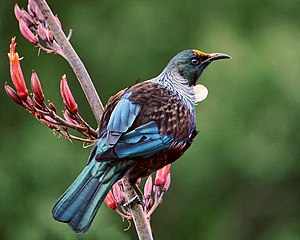Tui (bird)
| Tui | |
|---|---|
 |
|
| Tui on a flax flower stalk, with pollen on its head | |
| Scientific classification | |
| Kingdom: | Animalia |
| Phylum: | Chordata |
| Class: | Aves |
| Order: | Passeriformes |
| Family: | Meliphagidae |
| Genus: |
Prosthemadera G.R. Gray, 1840 |
| Species: | P. novaeseelandiae |
| Binomial name | |
|
Prosthemadera novaeseelandiae (Gmelin, 1788) |
|
The tui (Prosthemadera novaeseelandiae) is an endemic passerine bird of New Zealand. It is one of the largest members of the diverse honeyeater family. The name tui is from the Māori name tūī and is the species' formal common name. The plural is tui in modern English, or ngā tūī in Māori usage; some speakers still use the '-s' suffix to produce the Anglicised form tuis to indicate plurality, but this practice is becoming less common. The early European colonists called it the parson bird, but, as with many New Zealand birds, the Maori name tūī is now the common name and the English term is archaic.
At first glance the bird appears completely black except for a small tuft of white feathers at its neck and a small white wing patch, causing it to resemble a parson in clerical attire. On closer inspection (see image) it can be seen that tui have brown feathers on the back and flanks, a multicoloured iridescent sheen that varies with the angle from which the light strikes them, and a dusting of small, white-shafted feathers on the back and sides of the neck that produce a lacy collar.
Tui are found through much of New Zealand, particularly the North Island, the west and south coasts of the South Island, Stewart Island/Rakiura and the Chatham Islands—where an endangered sub-species particular to these islands exists. Other populations live on Raoul Island in the Kermadecs, and in the Auckland Islands (where, with the New Zealand bellbird, it is the most southerly species of honeyeater). Populations have declined considerably since European settlement, mainly as a result of widespread habitat destruction and predation by mammalian invasive species.
...
Wikipedia

